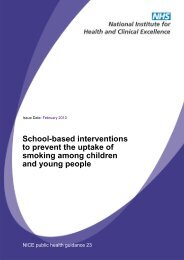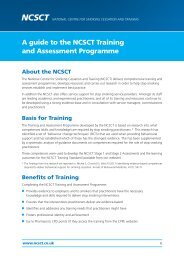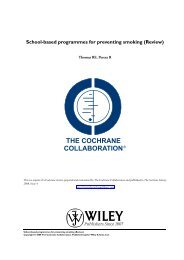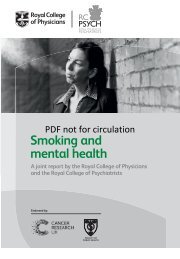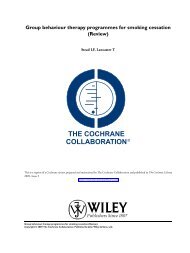published
published
published
Create successful ePaper yourself
Turn your PDF publications into a flip-book with our unique Google optimized e-Paper software.
Smoking in Pregnancy Project Report: June 2012<br />
2.2.1 Benefits of the proposed approach<br />
One of the intended key benefits of implementing this level of the tiered model was the<br />
potential for maximising opportunities for referral along the various stages of pregnancy<br />
and into the postnatal period by a number of health care professionals. This provided further<br />
opportunities for referral and re-referral and was based upon the premise that utilising a<br />
common health assessment and referral framework in regard to smoking during pregnancy<br />
and postpartum by a number of health professionals, would provide a systems based<br />
integrated service model for pregnant smokers.<br />
The intention was to provide a seamless, more efficient and effective referral system from<br />
the referrer to the stop smoking service provider. The development of an electronic referral<br />
system had the potential to provide the local area with the opportunity to capture data that<br />
would inform local planning for service provision in the future.<br />
2.2.2 The electronic referral system<br />
To support the pilot an electronic referral system was developed by AN Computing called<br />
the National Pregnancy Referral System (NPRS). This system is a web based data management<br />
tool that registered users can use to refer pregnant women, partners and other family<br />
members to the local stop smoking service(s). The system was also designed to include a<br />
feedback mechanism so that referrers could receive notification of the referral outcome.<br />
From a user perspective, referring a client involved little more than completing the client’s<br />
details and submitting the referral.<br />
In addition, as the pilot site (see below) used the Quit Manager (QM) database, additional<br />
development work was carried out to ensure that the two systems would recognise and<br />
work together, so that referrals made via the NPRS system would be successfully received<br />
directly into the QM database.<br />
2.2.3 The pilots<br />
In July 2011, a request for expressions of interest for pilot areas was disseminated to the<br />
services that had responded to the NCSCT smoking in pregnancy survey (see 1.5.2), alongside<br />
an eligibility criteria checklist (see annex B). Based upon responses to the checklist a pilot<br />
site, Central and Eastern Cheshire Primary Care Trust (PCT), was chosen.<br />
In 2010, Central and Eastern Cheshire had a smoking rate of 20.1%. The local prevalence<br />
of smoking in pregnancy is measured by the smoking at time of delivery data provided by<br />
two Maternity Units within the PCT, Leighton Hospital Maternity Unit and Macclesfield<br />
District Hospital. At the time of the pilot the reported smoking rate was 18% in Leighton<br />
and 13% in Macclesfield.<br />
16




